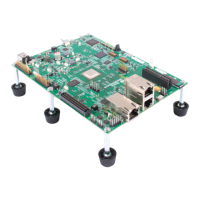The
TMS34010
C Language
4.4
Object
Alignment
All objects except structure members and array members
are
aligned on a
16-bit
(one
word)
boundary. In other words,
with
the exception
of
structure
and array members,
all objects begin at
bit
addresses whose
four
LSBs are
zeros.
In addition, because
of
the TMS3401
O's
bit
addressability, pointers can
point
to
any
bit
address. Signed objects
of
less than
16
bits
are
sign-extended
to
16
bits. Unsigned objects
of
less than
16
bits
are
zero-extended
to
16
bits.
Structure or array members
are
not
aligned
to
16-bit
boundaries. However, the
structure
or
array itself begins at a
16-bit
boundary. In the case
of
an
array
of
structures,
only
the first structure in the array
is
constrained
to
begin on a
16-bit
boundary.
For additional information on array alignment,
see
Structure Packing and Field
Manipulation, 5-3.
4.5
Conversions
K&R 6.1 Integer objects
are
always widened
to
32
bits when passed
as
arguments
to
a
function. Signed objects
of
less than
32
bits
are
sign-extended
to
32 bits;
unsigned objects
of
less than
32
bits
are
zero-extended
to
32
bits.
K&R6.3
K&R
14.4
The type char
is
signed and
is
therefore sign-extended
when
widened
to
in-
teger type. Sign extension can be disabled
by
using the type unsigned char.
Float and double types
are
converted
to
integer types by truncation.
All float variables
are
converted
to
doubles before arithmetic operations
or
before being passed
as
arguments
to
a function. .
Pointers and integers (or longs) may be freely converted, since each occupies
32
bits
of
storage.
Pointersto
one data type can also be converted
to
pointers
to
another data type, since the TMS3401 0 has no alignment restrictions and
all pointers
are
the same size.
4.6
Expressions
4.6.1
Void
Expressions
Added
type
4-4
A function
of
type
void
has no value (returns
no
value) and cannot be called
in any
way
except
as
a separate statement
or
as
the left operand
of
the comma
operator. Functions can be declared or typecast
as
void.

